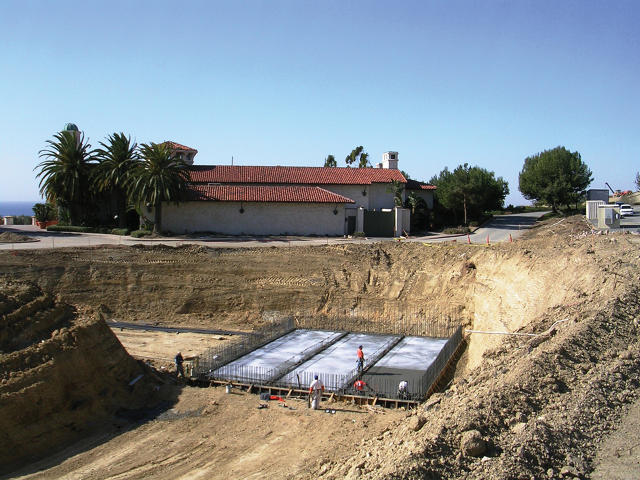In the middle of California’s epic drought, the state’s sprawling golf courses seem like an obvious villain: In a single day, a typical course uses as much water to stay green as an average family of four might use in an entire year. But is it possible for golf courses to manage water sustainably?
One Southern California golf course thinks it has a model that can survive the ongoing drought, with a complex system that uses only recycled and reclaimed water—and uses so little of it that it can store millions of extra gallons whenever the area does get a little rain.
“We went to unprecedented lengths to design and install a water-management system based on conservation and recycling, designed to protect the area’s most important asset: the Pacific Ocean,” says Stephen Friedlander, vice president of golf at Pelican Hill, a resort south of Los Angeles.
 Located in front of the tee boxes on the Ocean South course’s hole 10, the fabric-lined bio- filtration basin captures water runoff from the Golf Club’s maintenance facility and filters it through grass, gravel, sand, soil, and finally through the filter fabric into an underground drainage system.
Located in front of the tee boxes on the Ocean South course’s hole 10, the fabric-lined bio- filtration basin captures water runoff from the Golf Club’s maintenance facility and filters it through grass, gravel, sand, soil, and finally through the filter fabric into an underground drainage system.
Throughout the resort, cisterns capture runoff during rainstorms, holding up to 1.2 million gallons of water that otherwise would have drained into the ocean. When the cisterns fill, they’re emptied into reservoirs that double as water features for the course. In a year, the system can conserve 50 million gallons of water (in a rainy year, 60 million gallons). The resort also uses recycled wastewater from the city, which helps it completely avoid the use of tap water on grass.
After using moisture meters to measure exactly how dry each green is and how much water the soil can hold, the resort uses smartphone apps to water only the areas that need it. Instead of turning on every sprinkler in an area, they might only turn on one. “Essentially, we meticulously micro-manage water use across every corner of the golf course that requires irrigation,” Friedlander says.
The course also uses drought-tolerant Bermuda grass on tees and fairways and recently added more of the grass to 18 acres of rough turf. It plans to convert more acres over the next several years. Other non-playing parts of the course are filled with native plants that don’t need to be watered. While artificial turf is also used in some places, the course says it doesn’t want to use it widely because of a fundamental challenge: Fake turf doesn’t let the ground absorb water when it rains. It also can’t support urban wildlife that use golf courses as a place to live.
 Pictured during installation in 2007, this 240,000-gallon cistern handles water runoff from Pelican Hill’s main entrance and parking structure.
Pictured during installation in 2007, this 240,000-gallon cistern handles water runoff from Pelican Hill’s main entrance and parking structure.
“Artificial turf prohibits whatever rainfall a property receives from entering the underground aquifers and creating future drinking water,” says Friedlander. “Golf courses with hundreds of acres of turf grass have a significant positive footprint that contributes oxygen and a place for wildlife, including hundreds of species of birds, mammals, and reptiles. Without turf and natural habitat, those species could eventually be forced out of their homes.”
Of course, some might still ask the question of whether green golf courses make sense at all in an arid climate—especially if the drought continues. Still, if most urban rainfall is wasted anyway, washing off roofs and streets and into storm drains, it’s possible that there could be enough rain to go around. Cities would just need to manage water as well as this particular golf course does.
And with golf a $6 billion industry in the state, the sport unlikely to completely disappear. The question is how quickly other golf courses can adapt to the drought. Switching to recycled and reclaimed water, for example, is slow and expensive; pipes alone can cost $1 million per mile. Still, as new water restrictions from the governor force golf courses to cut back on irrigation, change is starting.
“At this time, only 37% of California golf courses use reclaimed water to irrigate,” says Friedlander. “There is significant opportunity for all golf courses to become more drought-friendly.”